Bsc 108 exam 1 alabama - Study guides, Revision notes & Summaries
Looking for the best study guides, study notes and summaries about Bsc 108 exam 1 alabama? On this page you'll find 40 study documents about Bsc 108 exam 1 alabama.
Page 4 out of 40 results
Sort by

-
BSC 108 Exam 1 – ALABAMA | 50 Questions with 100% Correct Answers | Verified | Latest Update 2024
- Exam (elaborations) • 5 pages • 2023
-
- £6.52
- + learn more
Domain Eukarya contains animals, plants, protists, and fungi. - True The process of keeping internal conditions constant is known as - Homeostasis The levels of biological organization, in order from least complex to most complex, are: biosphere, ecosystems, communities, populations, organisms, organ systems, organs, tissues, cells, atoms, molecules. - False A new species has been discovered. Individuals of this species are multicellular eukaryotes that obtain nutrients from decomposing or...
BSC 108 (Exam 1-3,Exam 1 ALABAMA,Test 1-3,YATES FINAL ) BUNDLED 100% Correct answers Verified 2024 Version
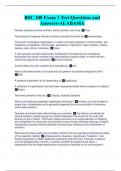
-
BSC 108 Exam 1 Test Questions and Answers-ALABAMA
- Exam (elaborations) • 4 pages • 2024
- Available in package deal
-
- £8.15
- + learn more
Domain Eukarya contains animals, plants, protists, and fungi. True The process of keeping internal conditions constant is known as Homeostasis The levels of biological organization, in order from least complex to most complex, are: biosphere, ecosystems, communities, populations, organisms, organ systems, organs, tissues, cells, atoms, molecules. False A new species has been discovered. Individuals of this species are multicellular eukaryotes that obtain nutrients from decomposing organ...
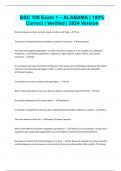
-
BSC 108 Exam 1 – ALABAMA 100% Correct Verified 2024 Version
- Exam (elaborations) • 5 pages • 2024
- Available in package deal
-
- £6.52
- + learn more
BSC 108 Exam 1 – ALABAMA | 100% Correct | Verified | 2024 Version Domain Eukarya contains animals, plants, protists, and fungi. - True The process of keeping internal conditions constant is known as - Homeostasis The levels of biological organization, in order from least complex to most complex, are: biosphere, ecosystems, communities, populations, organisms, organ systems, organs, tissues, cells, atoms, molecules. - False A new species has been discovered. Individuals of this species a...
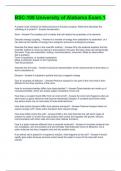
-
BSC-108 University of Alabama Exam 1 Questions and Answers
- Exam (elaborations) • 5 pages • 2024
-
- £9.16
- + learn more
BSC-108 University of Alabama Exam 1 A protein must maintain its folded structure to function properly. What term describes the unfolding of a protein? - Answer-denaturation Atom - Answer-The smallest unit of matter that still retains the properties of an element, Describe energy coupling. - Answer-It is transfer of energy from catabolism to anabolism, or it can also be the transfer of energy from exergonic process to endergonic process. Describe the basic steps in the scientific met...
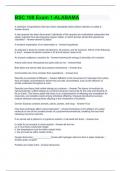
-
BSC 108 Exam 1-ALABAMA QUESTIONS AND ANSWERS
- Exam (elaborations) • 3 pages • 2024
-
- £7.66
- + learn more
BSC 108 Exam 1-ALABAMA A collection of hypotheses that have been repeatedly tested without rejection is called a - Answer-theory A new species has been discovered. Individuals of this species are multicellular eukaryotes that obtain nutrients from decomposing organic matter. In which domain should this species be classified? - Answer-domain Eukarya A tentative explanation of an observation is - Answer-hypothesis An element is found to contain 33 electrons, 33 protons, and 22 neutrons...
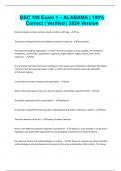
-
BSC 108 Exam 1 – ALABAMA 100% Correct Verified 2024 Version
- Exam (elaborations) • 5 pages • 2024
-
- £6.52
- + learn more
Domain Eukarya contains animals, plants, protists, and fungi. - True The process of keeping internal conditions constant is known as - Homeostasis The levels of biological organization, in order from least complex to most complex, are: biosphere, ecosystems, communities, populations, organisms, organ systems, organs, tissues, cells, atoms, molecules. - False A new species has been discovered. Individuals of this species are multicellular eukaryotes that obtain nutrients from decomposing or...
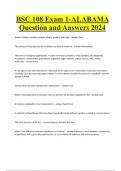
-
BSC 108 Exam 1-ALABAMA Question and Answers 2024
- Exam (elaborations) • 5 pages • 2024
-
- £7.34
- + learn more
BSC 108 Exam 1-ALABAMA Question and Answers 2024 Domain Eukarya contains animals, plants, protists, and fungi. - answer-True The process of keeping internal conditions constant is known as - answer-Homeostasis The levels of biological organization, in order from least complex to most complex, are: biosphere, ecosystems, communities, populations, organisms, organ systems, organs, tissues, cells, atoms, molecules. - answer-False A new species has been discovered. Individuals of this species...
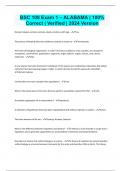
-
BSC 108 Exam 1 – ALABAMA | 100% Correct | Verified | 2024 Version
- Exam (elaborations) • 5 pages • 2024
-
- £10.60
- + learn more
Domain Eukarya contains animals, plants, protists, and fungi. - True The process of keeping internal conditions constant is known as - Homeostasis The levels of biological organization, in order from least complex to most complex, are: biosphere, ecosystems, communities, populations, organisms, organ systems, organs, tissues, cells, atoms, molecules. - False A new species has been discovered. Individuals of this species are multicellular eukaryotes that obtain nutrients from decomposing or...
BSC 108 Exam 1-ALABAMA | 50 Questions with 100% Correct Answers | Updated 2024

Do you wonder why so many students wear nice clothes, have money to spare and enjoy tons of free time? Well, they sell on Stuvia! Imagine your study notes being downloaded a dozen times for £15 each. Every. Single. Day. Discover all about earning on Stuvia




